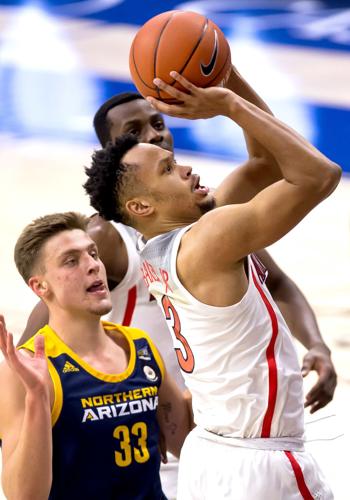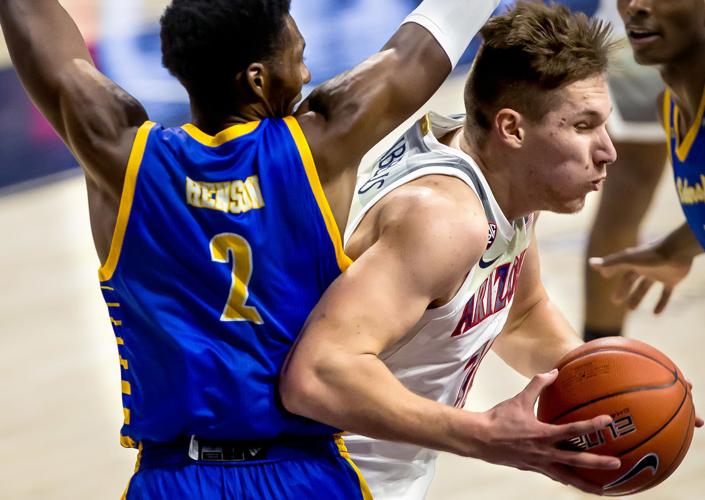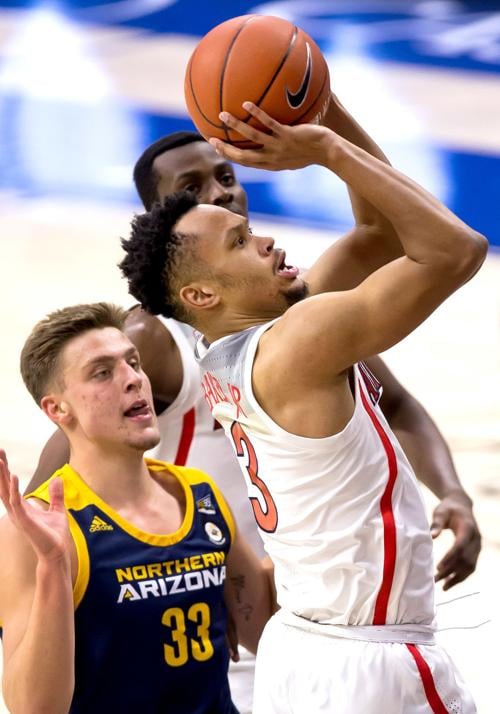Over the first month of Arizona’s season, half of the Wildcats’ scheduled games never happened, one was played in a glorified tent and the only “fans” on hand have been animated but motionless and silent pieces of cardboard.
Things have not been normal, not anything close. But there were enough games for the 6-1 Wildcats to begin shaping an identity, to begin defining roles and to begin preparing for the bulk of Pac-12 play that is scheduled to start Monday against Colorado (in a rescheduled game that was originally set for Dec. 2, of course).
Here are five things that surfaced:
1. Jemarl Baker can shoot it in front of any backdrop
When Baker led Arizona to a 75-72 win before Washington’s rowdy fans last season by scoring a then-career high of 17 points with 4-of-7 3-point shooting, including a go-ahead 3 with 44 seconds, it might have looked a little fluky.
Baker shot just 26.3% from 3 during Pac-12 play last season and 34.3% overall. But the truth was this: Baker was playing all season with knee issues, he was handling both guard spots off the bench behind Nico Mannion, Josh Green and Dylan Smith — and he wasn’t needed to score as much with those guys around him.
Everything has changed for Baker this season: He’s healthy, and he has been moved almost entirely off the ball and into a featured scoring role as the starting shooting guard. Without the still-ineligible Kerr Kriisa in the rotation, the Wildcats have leaned heavily on Baker to be their top 3-point shooter (45.5), although Bennedict Mathurin (7 for 16) and Terrell Brown (5 for 11) have carefully added to UA’s respectable 3-point shooting.
The Wildcats don’t shoot a lot of 3s (just 34.3% of their overall shots, the 225th highest percentage in Division I) but they make them at the 51st best rate (37.5%). Baker takes 57.1% of his shots from 3 and hits them at the 168th best mark — often in bunches.
Baker hit his first seven 3s against NAU on Dec. 7, finishing 7 for 9 with a career-high 33 points, and he could have tied the UA 3-point percentage record for games with a minimum of 10 3s taken if he had just missed another one.
After missing all four he tried against UTEP on Dec. 12, Baker rose up in the second half against Stanford on Dec. 19. In a tentlike, semi-warehouse setting that houses the Golden State Warriors’ G League team, a venue necessitated by stiff health regulations in Stanford’s home county, Baker poured in 7 of 10 3s in the second half.
That broke by one the school record for 3s made in a half set by Smith, Damon Stoudamire, Chris Mills and Matt Othick, and put the UA in position to have a chance in a game it trailed 30-23 at halftime and allowed the Cardinal to shoot 52.7%.
“Just wanted to win,” Baker said. But Miller did the most talking about him.
“Offensively he was a monster,” Miller said of Baker. “He played great, and he’s off to a great start. ... Like everybody, there’s certain things maybe defensively he could do better. But if it wasn’t for his offense, we wouldn’t have had a chance to be in the game tonight.”
2. The Wildcats’ Eurohaul has been mostly as advertised
When Arizona signed five European freshmen to complete its roster last spring as the pandemic began to rage, it wasn’t difficult to imagine that at least one of them either wouldn’t show up or wouldn’t get eligible.
That happened when Kriisa became stuck in the NCAA clearinghouse over previous arrangements he had made to play for the Lithuanian club Zalgiris, and it wasn’t until Dec. 21 that the NCAA ruled he could play starting Feb. 6.
The Wildcats also lost French forward Daniel Batcho until at least late January because of a knee injury, though he was projected as a backup as a freshman this season. The rest of the gang has been about what was expected so far: Tibet Gorener of Turkey has potential as a big perimeter shooter, hitting 2 of 3 3s against NAU, while Tautvilas Tubelis is a reserve wing who also is the brother of Azuolas Tubelis, the Lithuanian forward who ESPN called the best European player to take the college route in 2020.

Freshman forward Azuolas Tubelis, right, has shown constant improvement in his first season of American basketball. He recently moved into the Wildcats’ starting five.
Azoulas Tubelis has started to live up to that hype with a wide array of skills that are becoming increasingly visible as he adjusts to college basketball. He’s among Kenpom.com’s national leaders in offensive rebounding percentage (collecting UA’s misses 13.0% of the time he’s on the floor), defensive rebounding percentage (19.0%), fouls drawn per 40 minutes (7.0), block percentage (5.3% of opponent possessions when he’s on the floor) and steal percentage (3.7).
“It’s not that hard to adapt, but it’s different with (U.S.) rules,” Tubelis said last Tuesday, admitting that he had no clue he could be called for a technical foul for hanging on the rim as he was during the UA’s 70-64 win over Montana. “I need to learn some more, I think.”
3. The freshman wings drip with upside
While the Wildcats have plenty of options to go with a smaller perimeter lineup, especially considering the steady play of veteran combo guard Terrell Brown, they also haven’t gone wrong while trading 6-foot-7-inch freshmen Dalen Terry and Bennedict Mathurin at small forward.
Terry remains the starter, in part because he gives the Wildcats another ballhandling presence, with 2.5 assists per game and better than a 2-1 assist turnover ratio.
But while Mathurin has been coming off the bench, he’s actually the Wildcats’ fourth “most used” player as defined by Kenpom.com’s percentage of possessions used: On 23.7% of the UA’s possessions when he’s on the floor, Mathurin ends the possession either with a shot made, a shot missed that was not rebounded by the Wildcats or a turnover.

Arizona guard Bennedict Mathurin (0) rams down a dunk against UTEP in the second half of their game at McKale Center, Tucson, Ariz., December 11, 2020.
A bouncy wing from Montreal who can attract fouls (5.8 per 40 minutes), Mathurin also takes advantage of them by making 20 of 25 free throws — and he’s been the Wildcats’ second-best from 3 after Baker (7 for 15). When Baker was in foul trouble during the UA’s season-opener against Grambling State, Mathurin also played shooting guard.
“Azuolas, Benn and Dalen are going to continue to grow and develop with every practice and every game,” Miller said after the Grambling game.
“We just have to continue to get them more experience.”
4. Their foul game is upside down
While the Wildcats know how to attract fouls, they aren’t exactly good at capitalizing on them. The UA has the 14th-highest ratio of free throws attempted to field goals attempted and has four players who draw five or more fouls per 40 minutes — Mathurin, Tubelis, James Akinjo and Jordan Brown — but they are shooting a decidedly below-average 68.5% at the line.
After they made just 19 of 34 free throws against Montana — actually scoring one point less from the line than the Griz, who went there just 22 times — Miller noted that “moving forward, we’re not going to have the luxury of shooting 55% and winning.”
Arizona also hit just 52.2% against Stanford, leaving it unable to take advantage of the Cardinal’s 59.1% free throw shooting.
Meanwhile, the Wildcats are fouling too much themselves on the offensive end. They were called for seven offensive fouls against both Eastern Washington and Stanford, and Miller has made it humorously clear that some of that is due to how the game is being called, suggesting that the Wildcats need to adjust — maybe also by picking up some charges itself while playing defense.
“We have to join the party and flop,” Miller noted wryly after the Dec. 5 Eastern Washington game, having noted in deadpan fashion that “college basketball is so much about running full speed and just falling down. Leaving the corners and a guy leaves his feet, sliding underneath him. Any big who’s got the ball in and around the goal, as he dribbles to turn — just fall down.
“I’m not even saying that to complain but we have to do a better job of drawing the charge ourselves — on the ball, off the ball, bigs — because it’s just, I mean, it’s crazy.”
After the Wildcats picked up another seven offensive fouls against Stanford, with Akinjo being called for what was effectively a game-clinching charge in the final seconds, Miller toned it down only somewhat.
“We have to cross-body block, we have to go vertical in the charge arc, like the NBA does,” he said. “We have to leave the corner and get there late. I mean, there’s so many things that I think we have to do a better job of to make our defense better.
“It’s not up to the officials to adjust; it’s up to the coach, the staff and the players. … Look, I’m not trying to be funny. It’s what it is. I mean that. That’s what we have to do. Our defense has to improve, and that’s one way we have to get back at it.”
Three days later, the Wildcats committed only two offensive fouls against Montana. But one of them was an overly aggressive move from Jordan Brown that took away from his otherwise standout effort with 15 points and six rebounds.
“He played a very good game,” Miller said of Brown. “He just has to get smarter in certain areas of the game. … Sometimes in and around the basket, it’s not (making a) hard turn; it’s having a little bit of feel that ‘the guy’s going to try to flop to take a charge on me, so I’m just going to turn softly and shoot a jump hook.’ Game experience helps that. But we need him to get a little bit smarter in certain areas and if he does, I think his game can really take off.”
5. Basketball is their escape
While the mistakes Brown and Tubelis made are exactly the sort you might expect from a team with so much inexperience, they have played with consistent effort and bond with one another — two things that may be related to their heavily restrictive off-court existence.
Despite the fact that the UA ranks 52nd-lowest in “minutes continuity,” a Kenpom.com measure of what percentage of minutes are played by the same players from the previous season to the current one, 59.2% of the UA’s made baskets have come off assists, the 54th-best mark in Division I.
“The biggest thing is that we’ve been together since late August, so we’ve kind of got that feel from each other,” Terrell Brown said. “We’re sharing the ball really well, and that’s the key to winning games.”
Unlike with many previous UA teams — or any humans, really — the Wildcats also generally haven’t let up or played down to the level of competition, despite lacking real fans in the stands to boost their energy.
Maybe that’s because basketball, more than ever, is the best thing in Wildcats’ lives these days: They have to get up early nearly every morning for COVID-19 tests, limit all social interactions and pretty much eat out of a box.
“I feel like my life is all basketball, really,” Terry said. “I feel like it’s better for me to be playing a pandemic than it was before because now I’m more focused. Every time I get bored, I go to the gym.”







